SPECIAL REPORT: By Victor Mambor in Jayapura – first of a three-part investigation into the Pastor Yeremia Zanambani assassination.
The Papua Province Humanitarian Team for Cases of Violence Against Religious Figures in Intan Jaya District [referred to as the Humanitarian Team from now on], has completed documenting the cases of extrajudicial killing of Pastor Yeremia Zanambani on 19 September 2020. This report documents facts about Pastor Zanambani’s murder.
It also provides an analysis of the context of violence by significant security actors, namely the TNI (Indonesian National Armed Forces) and TPNPB (National Liberation Army of West Papua), and its impact on civilians in Intan Jaya district.
The shooting of Pastor Jeremiah Zanambani’s incident cannot be seen as an isolated event. There has been previous incidents of violence since 17-19 September 2020. Starting with the gathering of Hitadipa residents twice on 19 September 2020, at 9am and 12 noon at the headquarters of the Hitadipa Preparation Koramil and the Imanuel Hitadipa Church yard. In the gathering of residents, Pastor Yeremia Zanambani – along with five other residents – was branded an “enemy” by the Deputy Commander of the Sub-District Military (Wadanramil) Alpius Hasim Madi.
The intimidation and threats given by Madi to make the residents return rifles belonging to the TNI made several residents present cry out in fear. An hour later, the TPNPB attack on the Preparatory Koramil Headquarters resulted in the death of Pratu Dwi Akbar Utomo. In that incident, the official house of the health worker in Taundugu was burned by TNI officers, then the shooting and stabbing took place which killed Pastor Yeremia Zanambani.
- READ MORE: Part 1: The Intan Jaya conflict: A risk of more widespread violence in future
- Part 2: The Intan Jaya conflict 2: Violence at the cost of many civilian lives
- Part 3: The Intan Jaya conflict 3: New autonomous region, new conflict
Pastor Zanambani is not the first victim in a series of police violence in Intan Jaya. He is the 10th civilian victim who has been shot at Intan Jaya between October 2019 and 2020. The armed conflict that has occurred in Intan Jaya since October 2019 is the latest in the series of violent episodes that have emerged since the Intan Jaya regency was formed in 2008.
The Humanitarian Team documented four problem groups in analysing the violence in Intan Jaya. First, there were changes in the characteristics of the conflict in Intan Jaya over several periods – 2014-2016, 2017-2018, and 2019-2020.
In the 2014-2016 period, Intan Jaya district was marked by several cases of violence perpetrated by the Indonesian security forces against civilians. According to the Humanitarian Team’s records, violence involving Brimob (Mobile brigade) members caused at least one citizen to die, and at least 21 residents were wounded.
Meanwhile, another security apparatus committed an additional case in which one civilian victim was killed. The violence was not directly related to political reasons but was incidental with personal motives or as a result of provocation.
Entering the beginning of 2017 to 2018, regional head elections (Pilkada) rivalry added to the dynamics of the conflict in Intan Jaya. The clash occurred between sympathisers of the regent candidate pair Yulius Yapugau-Yunus Kalabetme and the incumbent Natalis Tabuni-Robert Kobogoyauw.
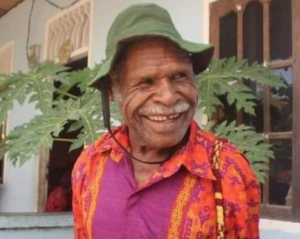
Three residents killed, 101 wounded
At least three residents died, and 101 others were wounded. As tensions escalated, the Papua police called in reinforcements for security. This tension has increased the fragility of the civilian government in responding to local security dynamics.
The change in the characteristics of the conflict in Intan Jaya has been clear since 25 October 2019. Intan Jaya has become a new armed conflict zone in Papua, due to the presence of two significant security actors, namely the TNI and TPNPB.
Violence has been escalating in the conflict since the shooting incident of Indonesian Army soldiers on 17 December 2019 to 6 November 2020.
The results of the Humanitarian Team documentation show that there were 17 cases of violence committed by both the TNI and TPNPB. The violence resulted in 17 deaths. A total of 12 civilians were killed, including a child.
The shift in the conflict trend is a significant change, because previously Intan Jaya district was not included in the conflict zone between the TNI and TPNPB. Previous conflicts were more related to communal issues, land ownership issues, clashes between residents and various other disturbances to security and public order.
When social conflicts such as tribal wars occur, traditional value-based conflict resolution is carried out by warring community groups to find a middle way.
The expansion of Intan Jaya from Paniai Regency in 2008 had implications for changing the trend of the conflict. The struggle for power by local elites through Pilkada elections in 2017 has had an impact on the legitimacy of the local government and its effectiveness.
On the one hand, the addition of organic and non-organic troops for the sake of securing the Pilkada election and in responding to various local security dynamics afterwards, has significantly increased the role of the TNI-Polri in the regency with a population of 49,293 people.
Struggle consolidated
On the other hand, TPNPB is increasingly consolidating its struggle by expanding Kodap [1] and reunification. After the TPNPB Summit in Biak Numfor on 1-5 May 2012, TPNPB already has 33 Kodap throughout Papua.
Intan Jaya itself is included in Kodap VIII. Internal consolidation was also strengthened by a meeting of Reunification and the Declaration of Unity and Unity of the TPNPB-Free Papua Organisation on 1 August 2019 Ilaga, Puncak Regency.[2]
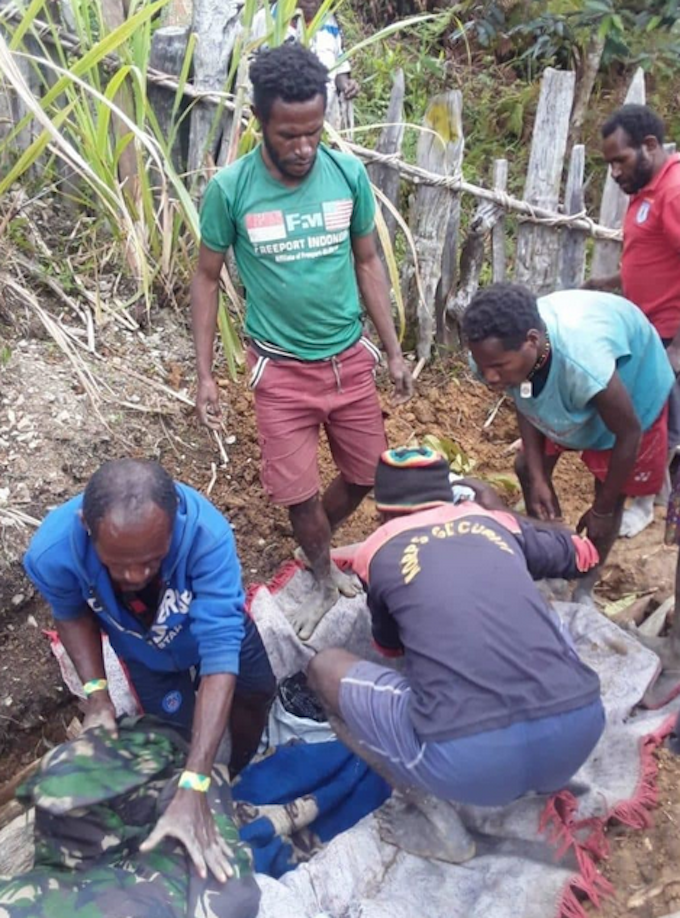
Since then, the intensity of the conflict between the TNI-TPNPB has increased in Intan Jaya district.
The interaction of these various factors contributed directly or indirectly to the changes in the characteristics of the conflict in Intan Jaya regency in 2014-2020. Now, Intan Jaya regency has become a new zone for a deadly security conflict.
According to the Humanitarian Team’s record, the highest number of victims in the conflict between the TNI and TPNPB were civilians, both Papuan and non-Papuan.
Second, it is difficult to obtain clear information about the addition of organic and non-organic troops to the TNI/Polri operations in Intan Jaya. After the restructuring of the TNI organisation on 27 September 2019, the Humanitarian Team also found it difficult to identify the division of tasks among stakeholders such as the XVII/Cenderawasih Regional Military Command, Korem 173/PVB, and Kogabwilhan III.
However, Kogabwilhan III seems to have more authority and plays a role in security operations in Intan Jaya.
Information dissemination
Throughout the series of violent and armed conflicts in Intan Jaya, information dissemination to the public was mostly carried out by the Kogabwilhan III Information.
After the shooting of Pastor Yeremia Zanambani, for example, the Head of Information for the Joint Defence Region Command III, Colonel Czi IGN Suriastawa, made a unilateral statement, saying that Pastor Zanambani was shot by the TPNPB. In the previous period, the delivery of similar information was mostly carried out by the XVII/Cenderawasih Military Command Information.
The implication is that it is difficult to ensure the accountability of the TNI for various human rights violations in Intan Jaya. The lack of independent and impartial investigations into various violence in TNI operations in Intan Jaya has further strengthened the structure of violence within the institution, including the practice of impunity.
Apart from the lack of information regarding the presence of TNI troops in Intan Jaya, the TNI has also violated International Humanitarian Law for occupying YPPGI Hitadipa Elementary School. The school was even used as the Headquarters of the Hitadipa Preparation Koramil (Military Rayon Commando). The use of public facilities for war purposes violates human rights. This deprivation has taken away the rights of students to attend school.
Third, there is neglect of victims’ rights to justice and reparation after various violent events since October 2019. In a number of cases of extrajudicial killings, there is minimal investigation and legal process against the TNI members involved. Until November 12, 2020, only the case of burning the official house of health workers in Taundugu has reached the investigation stage. The Indonesian Army Military Police Center (Puspomad) named eight Indonesian Army soldiers as suspects in the arson case.[3]
The lack of legal proceedings for various extrajudicial killings by security forces has resulted in impunity. People in Intan Jaya do not have access to justice and remedies for the various human rights violations that have occurred.
The Declaration of Basic Principles of Justice for Victims of Crime and Abuse of Power defines victims as “people who individually or in groups have suffered harm, including physical or mental injury, emotional suffering, economic loss or real deprivation of basic rights, either because of actions (by act) or because of negligence (by omission)”. So that the people of Hitadipa and Intan Jaya who experience direct and structural violence as a result of the conflict by security actors have the right to feel safe. Therefore, the State is obliged to guarantee justice and restoration of rights (reparations) for the people of Intan Jaya.
Fourth, the escalation of violence between the TNI-TPNPB also has an impact on the problem of refugees. Based on data compiled from the Indonesian Gospel Tent Church (GKII), the Timika Diocese Catholic Church and the Intan Jaya regency government, around 466 people were displaced.
Scattered in districts
They are scattered in several districts around Intan Jaya Regency and several other districts such as Nabire, Mimika and Puncak. This number is estimated to be even higher due to the difficulty of collecting data by the Humanitarian Team. In addition, the feeling of trauma experienced by residents causes fear of reporting to government agencies.
The large number of patrols by security forces in Sugapa and Hitadipa districts has also made it difficult for church pastors to record the overall distribution of refugees.
The problem of refugees from the previous armed conflict, such as refugees from Nduga district, for example, also shows a tendency for many civilians to flee into the forest, moving away from residential centres or government locations where the security forces are based.
Data collection difficulties will cause various humanitarian problems such as limited access to basic needs such as food, adequate housing, sanitation, education and health. The presence of refugee women, children and elderly people also require immediate special attention.
Another urgent matter is the fulfilment of security guarantees for the refugees to return to their hometowns to celebrate Christmas.
Fifth, the existence of the Wabu gold block risks triggering a new conflict (a resource war). Previous findings indicate a causal relationship between exploitation of natural resources, armed conflict and escalation of violence.[4]
In the analysis of the conflict in Papua, injustice in natural resource management has become one of the triggers.[5] Such exploitative development has an impact on the marginalization of local communities. With the social, political, economic and cultural background of the people of Intan Jaya, the patterns of injustice and marginalisation could worsen in the future.
Conflict-triggering elements
When people’s grievances due to imbalances in the distribution of results coincide with other conflict-triggering elements, other significant actors can construct these grievances to legitimise new violence. Because the most worrying thing about strategic natural resources such as gold is the manipulative competition between parties with different interests.[6]
The plan to mine the Wabu gold block in the midst of a situation of armed conflict between the TNI and TPNPB, will only lead to a conflict that is more complicated to resolve. TPNPB has conveyed its rejection of the Wabu block mining existence and specifically asked the Governor of Papua to withdraw the recommendation letter for the Special Mining Business Permit Area (WIUPK) Number 540/11625/SET issued in Jayapura on 24 July 2020.[7]
This resistance can produce a new cycle of violence if marginalisation worsens and the government continues to prioritise a security approach in its conflict resolution.
The Humanitarian Team’s findings indicate the risk of more widespread violence and conflict in the future. The security approach chosen by the government is dangerous, because the security forces have shown no attempt to change the culture of violence inherent in their institutional structures.
Groups of security forces have even shown a tendency to obscure the facts of the various violations they have committed, in order to protect perpetrators from legal traps by continuing to practice impunity.
The shooting of Pastor Yeremia Zanambani was an extrajudicial murder that violated human rights, international law, and the Indonesian Constitution. Pastor Jeremiah’s case proved not to be the last case, because afterwards there were the murders of two catechists of the Timika diocese.
The culture of violence inherent in the TNI institutional structure can only be changed if the practice of impunity is stopped by bringing the perpetrators of violence to justice.
To the Humanitarian Team, Mama Miriam Zoani, wife of the late Pastor Zanambani and family hopes that the security forces will leave Hitadipa, so that she can see the pastor grave for the first time. Mama Miriam Zoani also hopes that the displaced people will return to their homes, and together with their families do a thanksgiving service after Pastor Zanambani ‘s death.
It seems simple to most people. However, the presence of TNI officers in Hitadipa made it difficult for the family of Pastor Yeremia Zanambani to make it “simple”.
Translated from the original Tabloid Jubi article by a special Pacific Media Watch correspondent. Jubi articles are republished by Asia Pacific Report with permission.
Notes:
[1] Kodap adalah nama satuan teritorial TPNPB, yang biasanya berbasis kepada wilayah administrasi kabupaten di Papua.
[2] https://suarapapua.com/2019/08/14/perkuat-tpnpb-goliat-tabuni-cs-tolak-organisasi-tandingan/
[3] https://jubi.co.id/papua-delapan-oknum-tni-ad-tersangka-pembakaran/
[4] Edward Aspinall. The Construction of Grievance. Natural Resources and Identity in a Separatist Conflict. Journal of Conflict Resolution. 51(6), December 2017.
[5] The Indonesian Institute of Sciences (LIPI) mentions four roots of conflict in Papua, including the history of integration, political violence and human rights violations, development failures and problems of marginalization and inconsistency in the special autonomy policy. Various inequalities in development due to exploitation of natural resources cause social jealousy and become the root of conflict. According to Amich Alhumami, there are two main dimensions of the Papua conflict, namely the economic dimension and political domination. The economic dimension relates to the massive exploitation of natural resources without benefiting local communities. A sense of injustice due to economic problems can lead to conflict in the political sphere. See Suma Riella and Cahyo Pamungkas. Updating Papua Road Map. Peace Process, Youth Politics and Papuan Diaspora. (Jakarta: Yayasan Pustaka Obor Indonesia, 2017)
[6] Ichsan Malik. Resolusi Konflik, Jembatan Perdamaian (Jakarta: Penerbit Buku Kompas, 2017)
[7] https://suarapapua.com/2020/10/25/tpnpb-tegas-menolak-penambangan-emas-blok-b-wabu-intan-jaya/


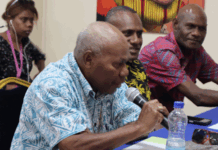




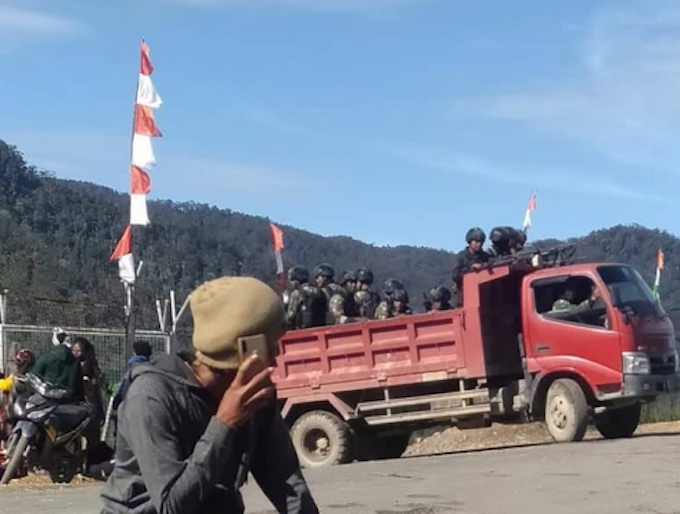
















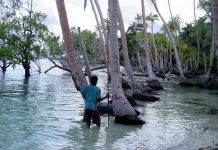






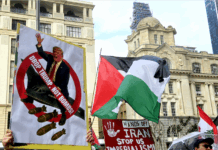
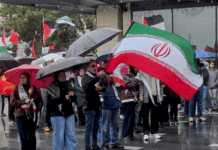




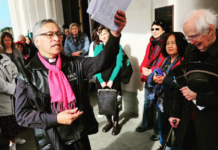









This an excellent investigative report
Comments are closed.